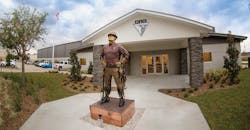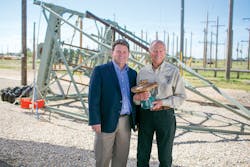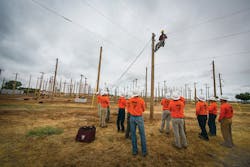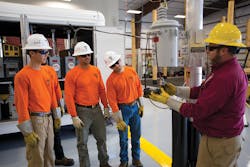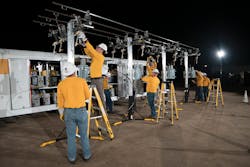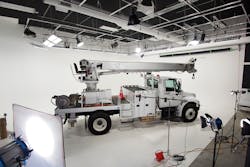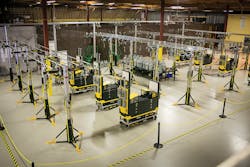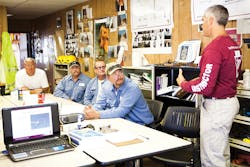Today in America, electric utilities are searching for the next generation of linemen to fill the work boots of the retiring journeymen. Meanwhile, high school students are contemplating the next step in their lives.
Aaron Howell, CEO of Northwest Lineman College (NLC), said the line trade needs to do a better job of putting lineworker on the table of options. “From my perspective, it’s not an issue of a labor shortage, it’s a marketing issue,” he said. “When young people are launching into their careers, we need to get the line trade next to the military, college and university.”
To make this happen, Quanta Services, a specialized contracting services company delivering infrastructure services to the electric power, oil, gas and communications industries, acquired NLC, a training and educational institution that trains pre-apprentices through experienced linemen. Together, they are working to recruit and retain the next generation of linemen. “We are beefing up our efforts in marketing to get them to select our industry,” Howell said. “Our trade is America’s best kept secret. Our jobs can’t be exported like in manufacturing, and we need linemen here in America.”
Over his career, Howell said he has had the luxury of spending time with the youth of the country, which gives him hope for the future. “I have a lot of faith in them,” he said. “While they may be known as the joystick generation, they respond well when they’re taught correctly and shown what it takes to succeed.”
Opening Its Doors
In the early 1990s, utilities and construction companies had a significant need for well-trained, beginning-level apprentices yet, at that time, very few lineworker pre-apprenticeship schools existed. The individuals who did have pre-apprentice training were employed quickly, which stimulated the need for more training, Howell said.
Gerald McKie, head of Boise State University’s lineworker program, first recognized this opportunity and worked with Howell to start NLC. At that time, Howell already had graduated from the lineworker program years before, and he was assisting McKie part-time while earning his business degree.
In 1993, NLC opened its doors with only the pre-apprenticeship program at a single campus in Meridian, Idaho. Today, NLC has three additional campuses in Texas, Florida and California. Over the years, more than 15,000 pre-apprenticeship students have graduated from its electrical lineworker program and 4500 from its apprenticeship program.
In the beginning, Howell said NLC was far less formal in its approach, although its commitment to improve the industry was high. From the start, NLC cared about its students, he said. “It is that unwavering commitment to the benchmark standard of training that made the difference over the years,” Howell said. “We always ask, ‘What’s best for the students?’ when making
decisions.”
When NLC first started, about a dozen pre-apprenticeship programs were operating across the country; now there are at least 62. Traditionally, pre-apprenticeship programs have focused heavily on basic skills, such as pole climbing, equipment operation, safety fundamentals and theory, which prepares students for success in their apprenticeships. However, most apprenticeship programs have similar topics in their first-year curriculum, and this overlap represents duplicated efforts, Howell noted.
By requiring the successful completion of a pre-apprenticeship program as a prerequisite to entry in an apprenticeship, today’s programs can thin some of the fundamental training and gain more time in other important topics such as safety, leadership, smart grid and live-line work among others, Howell said. He also said organizations operating apprenticeship programs can establish minimum standards for the educational institutions offering pre-apprentice programs.
Boosting Completion Levels
One way pre-apprenticeship programs have impacted the industry most significantly is through boosting the completion rates of apprenticeship programs. Case in point: A large utility’s completion rate before hiring NLC graduates was north of 50%. Today, the utility has a 96% completion rate, Howell said.
“The dollars that the utility is spending on apprenticeships are all being realized, and none of it is wasted,” Howell observed. “If the pre-apprenticeship schools are doing it correctly, they are properly preparing individuals to think about safety, training and education. If they frame their minds early, when they get on with the utility and construction companies, these behaviors become integrated.”
Howell believes the power industry has a lot of misnomers such as, “That is a really good apprenticeship because only 15% made it through it.” In his opinion, that is more of a screening program than a training program. Instead, Howell said utilities must try to do a better job up front of selecting applicants, like how the National Football League conducts its yearly Scouting Combine. The goal for any apprenticeship program should be to graduate 100% of the apprentices, he said. Not all will make it to the end of the program but that should still be the goal, Howell said, noting there should be a distinction between selection processes and training programs.
“When I talk to people in the trade, I ask them if they had a magic wand and could collect 20 of the very best lineworkers who were all 20 years old, what would their completion rate be?” he asked. “It should be 100%. If the completion rate of a program is low, then a company doesn’t have a good selection process. That is one thing that we can get a lot better at in this industry. We need to have a healthy screening program up front.”
Howell has seen many utilities offer boot camps, but he said this term does not suggest quality education. “If you want to do a boot camp, do it in the selection process,” he advised. “Once you weed the applicants and find those who have the moxie, then you can launch them to the next level with a quality training program.”
Apprenticeship Training
Because most apprenticeship programs were designed shortly after World War II, the industry is in a good position to advance and improve apprentice training significantly, Howell noted. “The need for training in this industry is acute; it was no different in 1993,” he recalled. “At that time, however, we were providing only pre-apprentice training. As power and construction companies realized that our graduates were highly successful completing their apprenticeship programs, they recruited more. This drove enrollments and we slowly grew. Power and construction companies began asking, ‘What else do you do?’”
While NLC is primarily known for its pre-apprenticeship programs, it also offers four-year apprenticeships in both distance learning and on-campus formats. Courses include but are not limited to safety, rigging, transformers, live-line work, personal protective grounding, journeyman excellence, electrical equipment, smart grid and more.
As the current programs continue to grow their video and manufacturing divisions, NLC now is expanding into other areas such as natural gas distribution and telecommunications pre-apprenticeship training to meet the needs of Quanta Services and other clients. The initial telecom program has been delivered twice, and the gas distribution program will be delivered in September 2018.
Duke Austin, president and CEO of Quanta Services, said this training will benefit Quanta, the industry and its customers. Going forward, he also foresees other training areas that can be addressed. “We believe NLC’s educational models can be applied to all of Quanta’s service lines, which would facilitate the development of additional curricula over time,” Austin said.
Howell said Quanta and NLC are both helping each other to improve. For example, through the acquisition, NLC automatically improved Quanta’s safety and training through a larger, more formalized effort.
Also, NLC is training future linemen, some of whom will eventually work for Quanta’s operating units.
“NLC is helping Quanta to get more people in gas, telecom and in their operating units on the power side,” Howell said. “Opportunity for our pre-apprenticeship students has increased as both Quanta companies and the utilities they serve have increased recruiting on our campuses.”
Matt Compher, vice president of safety, health and environmental for Quanta Services, said the passion NLC has for the industry and its employees aligns perfectly with his company’s passion. For example, NLC has developed a three-phase educational model, which transforms education in the power industry and helps to produce graduates that stand out in the labor market. “As we began to look at ways to support our growth, not only from a hiring standpoint but an education standpoint, we knew we needed additional resources,” Compher said. “We not only need new employees, we also need quality education to develop and progress our current workforce. No one is better at that than NLC.”
As Quanta looked at ways to better educate its workforce, it decided to acquire NLC, long a leader in the industry when it comes to safety and training. “Many of us have worked with NLC over our careers and/or interacted with graduates as the entered the workforce,” Compher noted. “The interactions with their graduates and seeing firsthand their workforce development and education made it a perfect fit.”
The next generation of employees in the power industry often asks questions like, “Where can I go from here?” and “How can I get there?” Quanta’s acquisition of NLC enables the company to show someone new coming into the trade a true career path from pre-apprentice all the way through leadership.
“NLC is putting more pre-apprentices in the market than anyone else in the U.S.,” Compher said. “As those graduates venture into the workforce, some will choose Quanta; others will work for competitors or clients, and that’s great. We believe this model will support the industry’s safe growth and help us retain a quality workforce that will lead us into the future.”
Training Demands
Today, between its distance learning and on-campus programs, NLC has 3500 apprentices across the U.S. The apprentices are employees of construction companies and utilities already, and NLC offers the apprenticeship program as a service. “If a power company has its own apprenticeship program and doesn’t want to do it anymore, it can contract it out,” Howell explained. “We can be a service provider that can do a formalized program.”
Small utilities and construction companies can opt to enroll their apprentices in distance learning, which is more in reach financially and meets the U.S. Department of Labor requirements for lineman certification. “Because it is distance learning, it is less expensive to deliver,” Howell said. “They need to identify someone who is the test facilitator, and we maintain the grades and the testing.”
Larger organizations, such as a midsize electric cooperative or an association of cooperatives, have come to NLC requesting an entire formalized apprenticeship program. “Quanta has a close relationship with their customers, and, in the future, as we grow and get systems in place, we can extend those resources,” Howell noted. “We are expanding rapidly. Quanta brought us 150-plus customers all at once.”
Mobile Training
Quanta as well as other utilities and construction companies work throughout the U.S., sometimes far from NLC’s four main campuses. To serve the needs of its customers, NLC’s trainers bring mobile training units right to their locations.
Through its mobile training task team, called Utility Training Services, NLC has a group of employees dedicated to traveling around the country and delivering training. For example, NLC recently entered into a partnership with the Michigan electric cooperatives and International Brotherhood of Electrical Workers (IBEW) to train 85 apprentices at its training facility.
In addition, for the last year, NLC has made a significant investment in its TransBanker transformer banking simulator, which is provided as a floor model or a self-contained mobile unit. Students can install and energize transformers and transformer banks at a low voltage, and then connect them to single- and three-phase loads. “Transformer wiring errors are a safety concern, cause claims and erode customer confidence,” Howell said. “The TransBanker allows lineworkers to practice in a safe, low voltage energized training environment without causing damage to customer equipment.”
With the mobile TransBanker, Quanta can take the show on the road as far as training, Compher added.
In addition, Howell said pre-apprentices through experienced linemen also can gain knowledge in NLC’s fully digitized classrooms, which provide a variety of delivery and evaluation methods. While new technologies can augment the training effort, they cannot replace it, Howell noted. “NLC always keeps an eye on training and education innovations,” he said. “New technologies must prove practical and effective before we dedicate resources. If one is not careful, precious resources are lost on technology with minimal return.”
Howell believes effective education is anchored in human interaction. “We will always remember our favorite teacher but not our favorite online training course,” he explained. “There are few substitutes for an exceptional trainer, equipped with modern curriculum and facilities, educating students on the most important topic.”
To ensure its instructors not only know the ins and outs of the line trade but also know how to teach, NLC requires its trainers to complete formalized training. Through NLC’s internal training department, called Grid University, the trainers learn through a progression program, similar to an apprenticeship. Once completed, NLC’s trainers earn a certification from the U.S. Department of Labor.
“Our trainers are subject matter experts from the field who are used to a production environment,” Howell said. “We want to teach them how to create an effective educational environment and keep their students’ brains engaged on a subject all day long, whether they are in the classroom or in the field.”
Expansion Plans
Along with training its trainers, NLC also ensures all four of its campus are mostly identical, thanks to an internal auditing program. Each campus has a unique and distinct backstory, and the size of the campuses is based on market demand. As NLC looks to the future, it does not currently have plans for a fifth campus but rather for growing its existing programs and locations. According to Howell, some areas are very conducive for pre-apprenticeship programs and NLC campuses while other locations are not a good fit.
“We are just keeping our ears to the rail,” Howell said. “When we think about expansion and where we want to go next, we are more driven from the perspective of where is the greatest need and how can we help.”
Compher said Howell and his team have done a great job with controlled growth and expansion by not pushing so hard that they would lose the NLC qualities of a professional education. “The quality education is what sets them apart, and we will never lose that,” Compher noted.
Going forward, NLC’s campuses will continue to operate as they have for many years, Compher added. On these campuses, Quanta will offer its apprenticeship training along with specialized training such as the TransBanker, grounding, and bonding and crane training.
Compher foresees growth in the pre-apprenticeship programs at each campus. Also, Quanta will develop a team within NLC who is focused on Quanta operating unit success and those training needs. Quanta will continue to work with its existing NLC clients and expand its training offerings to others in the utility market using the same three-phase educational model used in the development of the telecom and gas distribution programs. “As Aaron always says, ‘Imagine the possibilities,’” Compher said.
Because of the acquisition, NLC also will be able to expand at a faster rate, Howell noted. “We are all very excited to be part of the Quanta family,” he said. “Quanta believes in NLC and wants us to grow all of our services for all of our existing customers as well as Quanta operating units and customers.”
At NLC, Howell said he and his team love training and what it can do for the field workforce of America. “Training and education is so powerful,” he noted. “When you do it right, it can modify and enhance a career, and change the trajectory of people for their entire lives for the better. Our world view is that if someone needs our help, we will provide education, and if a company says they need training, we will do everything we can to meet that training need.”
Sidebar: Training Timeline
- 1993: NLC founded in Meridian, Idaho.
- 2002: Apprenticeship program established.
- 2000: National accreditation achieved.
- 2006: California campus opens.
- 2007: Utility Training Services created.
- 2009: Launched NLC Productions (video productions).
- 2010: Texas campus opens.
- 2010: Launched NLC Manufacturing.
- 2013: Grid University (internal training group) established.
- 2015: Alan Drew, senior vice president of research and
development at NLC, published The American Lineman
to document the accomplishments and evolution of
linemen. - 2016: Florida campus opens.
- 2017: NLC provides trainers to help with the Michigan
apprenticeship program in partnership with the IBEW
and the Michigan Electric Cooperative Association.
Overall, NLC trained 5600 people in this year alone. - 2018: Quanta Services acquires NLC in January 2018. NLC’s
management team, including founder Aaron Howell,
stay in their leadership positions.
About the Author
Amy Fischbach
Field Editor
Amy Fischbach is the field editor for the Electric Utility Operations section of Transmission & Distribution World. She worked for Prism Business Media (now Penton) for eight years, most recently as the managing editor of Club Industry's Fitness Business Pro magazine. She is now working as a freelance writer and editor for B2B magazines. Amy earned her bachelor's and master's degrees in journalism from Kansas State University in Manhattan, Kansas. She serves as the national vice president of the American Society of Business Publication Editors. She can be reached at [email protected].
